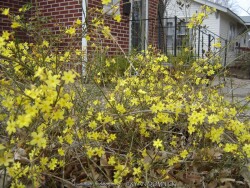

Winter Jasmine (Jasminium nudiflorum) is a spreading dwarf shrub native to China. It features dark green glossy leaves that remain attractive all summer. The density of the shrub overtime is unmatched, completely eliminating any weeds including tree seedlings from emerging. Bright yellow five-petaled flowers resembling forsythia bloom extremely early in the spring usually in February or March before foliage growth (in Lawrence, KS). Flower buds are hardy to about 0° so flowering may not occur every year if temperatures get lower. Occasionally this shrub will bloom in the middle of winter when we have a 2-3 week warm spell. When it does bloom, it creates a spectacular show completely covering the shrub. It will grow in full sun or full shade in medium to dry soils including some dry-shade. It tolerates moist soils and brief periods of saturated soils after heavy rains. Fall color is yellow but drops quickly. Stems take on an olive greenish color in winter rendering them mildly attractive. Winter jasmine is commonly grown as a spreading groundcover shrub for difficult areas, frequently used as large mass planting on hills. Because of its tolerance for adverse conditions including poor soil and rock, it is often one of the last resort plants that will survive in certain areas. It competes well under large shade trees and helps absorb leaf litter allowing it to break down and add nutrients back to the soil. This plant also does well in hot dry parking lot islands, hell strips, and along busy roads in full sun. Another great spot is planting on top of a retaining wall allowing it to cascade down. Further uses include erosion control and streambank stabilization. We do not recommend planting in small areas or in spaces that it will overrun neighboring plants. It only spreads above ground as horizontally growing stems touch the ground and root. This does make maintenance easier to control the spread of the plant versus digging out rhizomes. Avoid North exposures and wet soils. Considered one of the most versatile and best plants for solving difficult landscape challenges.
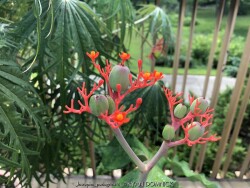

The foliage and red flowers of Jatropha make excellent specimen plants. Usually used as a patio or house plant in Kansas, they can also be grown as an annual. Grow in full sun to part sun with optional extra watering including that which comes from rainfall. Plants with time to acclimate will thrive in full sun but be careful not to rush it or sunburning will occur. Generally if moving outside for the summer, allow 2-3 weeks of part shade or morning sun before placing in full sun. Repotting may or may not be needed depending on how large you want the plant to grow. Protect from temperatures below 45 degrees F and move into a bright window over the winter with no watering. Do not allow Jatropha to freeze or get close to freezing especially if soil is wet or death will occur. As a winter house plant, it will look presentable all winter long with monthly waterings and bright light. As a permanent house plant, provide bright light and allow the soil to dry between waterings for a few years of enjoyment.
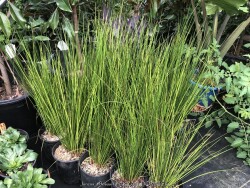

***Description for this grass available with future update!*** Juncus effusus is also known as Bog Rush / Juncus >>>>>This plant can also be used as a marginal aquatic plant growing in shallow water. It can also grow as a bog plant needing constantly moist soil rich in organic matter. As a rain garden plant, it will thrive is a depressed area in the landscape that collects rain water from a roof during spring and summer periods of rain but then go dormant if the water hole dries out completely.
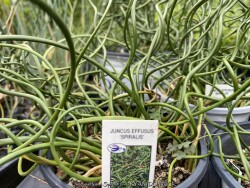

***Description for this plant available with future update!*** Juncus effusus 'Spiralis' is also known as Corkscrew Rush>>>>>> This plant can also be used as a marginal aquatic plant growing in shallow water. It can also grow as a bog plant needing constantly moist soil rich in organic matter. As a rain garden plant, it will thrive is a depressed area in the landscape that collects rain water from a roof during spring and summer periods of rain but then go dormant if the water hole dries out completely.


***Description for this grass available with future update!*** Juncus inflexus is also known as Blue Rush / Juncus >>>>>This plant can also be used as a marginal aquatic plant growing in shallow water. It can also grow as a bog plant needing constantly moist soil rich in organic matter. As a rain garden plant, it will thrive is a depressed area in the landscape that collects rain water from a roof during spring and summer periods of rain but then go dormant if the water hole dries out completely.
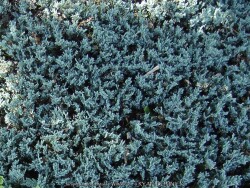

***Shrub descriptions available with future update!*** Juniperus horizontalis 'Wiltoni' is also known as Blue Rug Juniper.
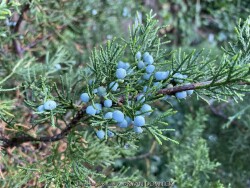

***Tree descriptions available with future update!***Eastern Red Ceder, is also known as Juniperus virginiana
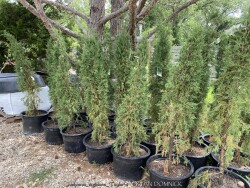

***Tree descriptions available with future update!*** Juniperus virginiana 'Taylor' is also known as Taylor Narrow Eastern Red Ceder
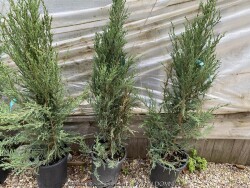

***Tree descriptions available with future update!*** Juniperus virginiana / scopulorum 'Skyrocket' is also known as Skyrocket Juniper